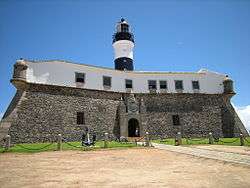Forte de Santo Antônio da Barra
Forte de Santo Antônio da Barra is a fort located in Salvador, Bahia, Brazil. It was constructed to guard the entrance to the Bay of All Saints, during the period of the Portuguese Empire. The first Portuguese fortification erected in Bahia was likely built in 1501, on the same area now occupied by the Forte de Santo Antônio da Barra. The foundation stone of that first fortification was placed in an area called Ponta do Padrão, now known as the Largo do Farol da Barra, the broad public square in front of the fort.
| Forte de Santo Antônio da Barra | |
|---|---|
| Salvador, Bahia in Brazil | |
 Lighthouse at Forte de Santo Antônio da Barra | |
 Forte de Santo Antônio da Barra Location of Forte de Santo Antônio da Barra in Brazil | |
| Coordinates | 13.010278°S 38.532778°W |
| Type | Fort |
| Site history | |
| Built | 1702 |
In 1549, in order to solve the governance problem of his South American colonies, King John III of Portugal established the Governorate General of Brazil.[1] The eighth Governor General, Manoel Teles Barreto (served 1583-1587), had a more substantive fortification built at the site. That structure, likely of rammed earth, was in the shape of an octagon. The tenth Governor General, Francisco de Souza (served 1591-1602), reinforced the fortification with stone and mortar; its design was similar to the 16th-century Small Fort of Our Lady of Monserrate.
In 1621, King Philip II of Portugal divided the Governorate General of Brazil into two states, with the site of the Forte de Santo Antônio da Barra located in the northern of the two, the State of Maranhão .[2] Governor General João de Lencastre (served 1694-1702) altered the plan of the site, hiring the military engineer José Paes Esteves to convert the fortification into a star-shaped polygon. A lighthouse was placed in the fort in the same period.[3][4][5]
See also
References
- Brasil Escola - Governo Geral
- Mundo Vestibular: BRASIL COLÔNIA
- "Heritage of Portuguese Influence/ Património de Influência Portuguesa — HPIP". www.hpip.org (in Portuguese). Calouste Gulbenkian Foundation. Retrieved 2017-07-08.
- Tirapeli, Percival (2000). Patrimônios da humanidade no Brasil. São Paulo, SP: Metalivros. p. 175. ISBN 8585371307.
- Tirapeli, Percival (2018). Patrimônio colonial latino-americano. São Paulo: Sesc. ISBN 9788594931221.